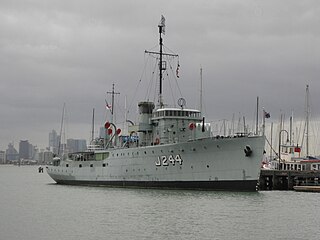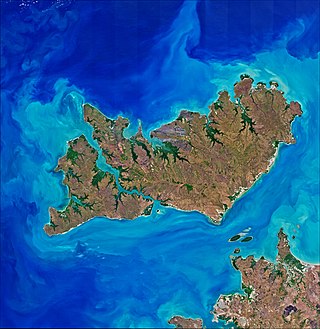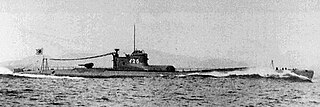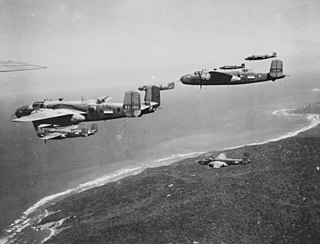Related Research Articles

The Bristol Type 156 Beaufighter is a British multi-role aircraft developed during the Second World War by the Bristol Aeroplane Company. It was originally conceived as a heavy fighter variant of the Bristol Beaufort torpedo bomber. The Beaufighter proved to be an effective night fighter, which came into service with the Royal Air Force (RAF) during the Battle of Britain, its large size allowing it to carry heavy armament and early airborne interception radar without major performance penalties.

Antoine François Fourcroy was a French chemist and a contemporary of Antoine Lavoisier. Fourcroy collaborated with Lavoisier, Guyton de Morveau, and Claude Berthollet on the Méthode de nomenclature chimique, a work that helped standardize chemical nomenclature.

HMAS Castlemaine (J244/M244/A248), named for the city of Castlemaine, Victoria, was one of 60 Bathurst-class corvettes constructed during World War II, and one of 36 initially crewed and commissioned solely by the Royal Australian Navy (RAN).

Bathurst Island is one of the Tiwi Islands in the Northern Territory off the northern coast of Australia along with Melville Island.

Between February 1942 and November 1943, during the Pacific War of World War II, the Australian mainland, domestic airspace, offshore islands, and coastal shipping were attacked at least 111 times by aircraft from the Imperial Japanese Navy Air Force and Imperial Japanese Army Air Force. These attacks came in various forms; from large-scale raids by medium bombers, to torpedo attacks on ships, and to strafing runs by fighters.
Fourcroy may refer to:

I-26 was an Imperial Japanese Navy B1 type submarine commissioned in 1941. She saw service in the Pacific War theatre of World War II, patrolling off the West Coast of Canada and the United States, the east coast of Australia, and Fiji and in the Indian Ocean and taking part in Operation K, preparatory operations for the Aleutian Islands campaign, and the Guadalcanal campaign, the Marianas campaign, and the Battle of Leyte Gulf. She was the first Japanese submarine to sink an American merchant ship in the war, sank the first ship lost off the coast of State of Washington during the war, damaged the aircraft carrier USS Saratoga (CV-3), sank the light cruiser USS Juneau (CLAA-52), and was the third-highest-scoring Japanese submarine of World War II in terms of shipping tonnage sunk. Her bombardment of Vancouver Island in 1942 was the first foreign attack on Canadian soil since 1870. In 1944, I-26′s crew committed war crimes in attacking the survivors of a ship she sank. She was sunk in November 1944 during her ninth war patrol.

Cape Crawford is a location in the Northern Territory in Australia. It is 100 kilometres south-west of Borroloola and is surrounded by savannah woodland, rock escarpments, waterfalls and waterholes. From here it is possible to organise a helicopter ride over the 'lost city' of the Limmen National Park. There is also an airport nearby called Cape Crawford Airport.

Royal Air Force East Fortune, or more simply RAF East Fortune, is a former Royal Air Force station located just south of the village of East Fortune. It is a short distance east of Edinburgh, in Scotland. RAFEast Fortune was used as a fighter station during the First World War and later used by a night fighter operational training unit during the Second World War. The motto of the station is "Fortune Favours the Bold".

HMAS Armidale (J240), named for the then town of Armidale, New South Wales, was one of 60 Bathurst-class corvettes constructed during World War II, and one of 36 initially manned and commissioned solely by the Royal Australian Navy (RAN).

No. 22 Squadron is a Royal Australian Air Force (RAAF) mixed Permanent and Reserve squadron that provides support for the RAAF in the Sydney region. Formed in 1936, the squadron served in Papua New Guinea during the Second World War, and later followed the Pacific War as far as the Philippines. Following the war, the squadron was re-formed in 1948 but was converted to a non-flying support role in mid-1960. It is currently based at RAAF Base Richmond, New South Wales.
I-21 was a Japanese Type B1 submarine which saw service during World War II in the Imperial Japanese Navy. She displaced 1,950 tons and had a speed of 24 knots (44 km/h). I-21 was the most successful Japanese submarine to operate in Australian waters, participating in the attack on Sydney Harbour in 1942 and sinking 44,000 tons of Allied shipping during her two deployments off the east coast of Australia.

Willem Janszoon captained the first recorded European landing on the Australian continent in 1606, sailing from Bantam, Java, in the Duyfken. As an employee of the Dutch East India Company, Janszoon had been instructed to explore the coast of New Guinea in search of economic opportunities. He had originally arrived in the Dutch East Indies from the Netherlands in 1598, and became an officer of the VOC on its establishment in 1602.
I-177 was an Imperial Japanese Navy Kaidai-type cruiser submarine of the KD7 subclass commissioned in 1942. She served during World War II, patrolling off Australia, taking part in the New Guinea campaign, operating in the North Pacific, and participating in the Palau campaign before she was sunk by the destroyer escort USS Samuel S. Miles (DE-183) in 1944, with no survivors.

The North-Western Area Campaign was an air campaign fought between the Allied and Japanese air forces over northern Australia and the Netherlands East Indies (NEI) between 1942 and 1945. The campaign began with the Japanese bombing of Darwin on 19 February 1942 and continued until the end of the war.
I-74, later I-174, was an Imperial Japanese Navy Kaidai type cruiser submarine of the KD6B sub-class commissioned in 1938. During World War II, she took part in the attack on Pearl Harbor, the Battle of Midway, the Guadalcanal campaign, the New Guinea campaign, and the Gilbert and Marshall Islands campaign and operated off Australia before she was sunk during her ninth war patrol in 1944.
I-11 was an Imperial Japanese Navy Type A1 submarine that served during World War II. Designed as a submarine aircraft carrier and submarine squadron flagship, she was commissioned in 1942. She participated in the Guadalcanal campaign and patrolled off Australia, New Caledonia, and the Ellice Islands before she disappeared in 1944 during her sixth war patrol. She badly damaged the Royal Australian Navy light cruiser HMAS Hobart in 1943.
Cape Fourcroy Light is an active lighthouse located on Cape Fourcroy, on the southwestern tip of Bathurst Island, Northern Territory, Australia. The lighthouse marks the beginning of the route from the Timor Sea to Darwin.

No. 255 Squadron RAF was a Royal Air Force Squadron formed as an anti-submarine unit in First World War and a night-fighter unit in the Second World War. The First World War squadron was formed from former Royal Naval Air Service coastal flights and was responsible for coastal anti-submarine patrols. It was disbanded after the war.

I-6 was an Imperial Japanese Navy J2 type submarine commissioned in 1935. She was a large cruiser submarine that served in the Second Sino-Japanese War and World War II. During the latter conflict she operated in support of the attack on Pearl Harbor, torpedoed the aircraft carrier USS Saratoga (CV-3), conducted anti-shipping patrols in the Indian Ocean and South Pacific Ocean, and took part in the Aleutian Islands campaign and New Guinea campaign before she was sunk in June 1944.
References
- ↑ "The Discovery and Exploration of Australia". australiaoncd.com.au. Archived from the original on 3 March 2011. Retrieved 25 October 2010.
- ↑ Dunn, Peter. "CRASH OF A BEAUFIGHTER NEAR CAPE FOURCROY, BATHURST ISLAND ON 31 DECEMBER 1942". www.ozatwar.com.
11°48′0.00″S130°1′0.00″E / 11.8000000°S 130.0166667°E